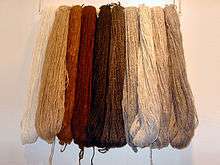Andean textiles
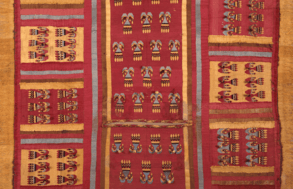
Andean textiles represent a continuing textile tradition spanning from the Pre-Columbian era to the Colonial era and present day. Textiles have encompassed a variety of functions, including woven textiles for ceremonial clothing, cloth armour, and record-keeping. Cultural emphasis in the textile arts is often based on the spiritual and metaphysical qualities of the origins of material, as well as cosmological and symbolic messages carried by its visual appearance.
Arid desert conditions along the coast of Peru have preserved dyed textiles dating as old as 6000 years.[1] Most surviving samples of woven textiles exist as funerary bundles. The textile arts were also instrumental in military and utilitarian use, both as armor and as diplomatic tools and exchanged during interpolitical negotiations.[2] Textiles are also used as a medium of communication, indicating a person's social status and regional affiliation.[3]
Traditionally, thread used for textiles was spun from indigenous cotton plants, as well as alpaca and llama wool. Synthetic threads have since replaced most animal fibers in modern textile arts.
Origins
Lithic Period
The earliest known surviving textiles are samples of fiberwork found in Guitarrero Cave, Peru dating back to 8000 BCE.[4] Early fiberwork by the Norte Chico civilization consisted of plant fibers that were intertwined and knotted to form baskets and other containers. Surviving examples of finely spun thread and simple cloths indicate that knowledge of spinning and weaving had already been well-established and developed in the area.
Mummified human skeletons dating to this period were stuffed with plant fibers and wrapped in rope and cane, a preservation method invented in the Chilean Chinchoros area around 5000 BC.[5] Existence of this technology demonstrates early knowledge of spinning naturally occurring fibers into cord.
Pre-Ceramic Era
Coastal civilizations were the first to create fishnets, and were the first to utilize the openwork tradition in knotted objects. The fishnets were created through twining, a non-loom technique similar to macramé.[4] Knotting patterns depicting standing humans, parrots, snakes, and cats have been decoded from surviving fragments.[3]
Initial Period
The introduction of camelid herding for their meat, fibrous hair, and ability to transport cargo was developed in response to remarkably inhospitable environmental conditions found in Andean highlands. As a result, alpacas and llamas were revered for their hardiness and ability to provide resources in both life and death.[6] The scaly fibers produced by these animals were both flexible and dye-permeable, allowing them to be woven with cotton to produce sturdy threads and textiles.
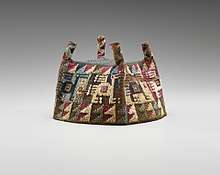
Chavín culture began to emerge around the late Initial Period (c. 900-500 BC). Surviving textiles found from looted burials feature brown dye painted on large, seamed panels of cloth. Textiles from the burials of Karwa are featured as ritual cult center objects, and depict explicitly feminine deities.[4] The Chavín culture may have demonstrated the first extensive production of textiles for ritualistic and symbolic purposes.
Paracas culture rapidly developed the textile industry into a time-intensive and labor-consuming practice. Embroidered and woven textiles became commonplace, featuring consistent repetition and variation of motifs. Nonwoven fabric structures, such as headbands, were created through cross-knit looping.[7] Paracas officials adopted the practice of wearing multiple garments in sets, including headbands, turbans, mantles, ponchos, tunics, skirts, and loincloths.[3]
Wari fiber arts featured large-scale textiles created in state-sponsored workshops. Political messages of abundance and control were depicted using chaotic geometric imagery and camelid-like figures.[6] Examples of surviving imagery (see image) feature multiple repeating motifs of highly geometric patterns, punctuated with highly expressive color palettes. Scholars have argued that the complexity of such designs broadcast the abilities and abundances of state-controlled resources.[8]
Late Intermediate Period
Record-keeping
Woven textiles

Manufacturing technique
Many textiles, such as baskets and fishing nets, did not require the use of a loom. The Andeans used the back strap loom to create woven textiles, as chronicled in El primer nueva corónica y buen gobierno. Several techniques were used to produce fabric, including plain weave, tapestry weave, and scroll weave. Smaller woven pieces produced on the same loom were often stitched together to create a larger fabric. Borders of embroidered tunics and mantles are often decorated with yarn tassels or fringe.[9]
Prehistoric Andean weavers pioneered new weaving techniques, such as the triple weave and quadruple weave. The use of fine yarn and consistency in stitch size is remarkable, with analyses counting an average of 250 wefts per inch on average, and some samples exceeding 500 wefts per inch. This is attributed to the regularity in diameter and consistency of thread, as well as maintenance of tension on the loom throughout the entire weaving process.[10]
A combination of cotton and dyed camelid threads contribute structural strength and colorful visual imagery to textiles. The scaly hair of camelids is permeable to dye, allowing natural plant-based dyes to be fixed to camelid fibers in the presence of a natural mordant, such as urine.[11] Complex combinations of coloration and patterning were used to repeat geometric patterns while maintaining visual consistency; Paracas textiles are especially well known for their regular gridlike arrangement of iconographic images. The consistency of scale and shape of these patterns point to the use of counting systems used by textile artisans to record the number of stitches and distance between each geometric pattern.[8]
Workshop production

Several different methods of embroidery are attributed to distinctive styles of coloring and depiction of images in woven textiles. Block color, linear, and broad line styles of embroidery imparted different visual effects upon the woven textile, and were used to convey different types of information.[3] Designs were also painted directly onto woven textiles using various dyes (see figure).
Professional textile artisans in pre-Incan cultures often worked in large workshops with artisans in several specialties. Proximity to other artisans allowed for additional features to be incorporated into plain weave textiles, including metallic threads, knotted strings of feathers, and brocading.[9] Textile painting was common practice in the preparation of special cloths for funerary bundles of high-ranking members of society. Pigments such as ochre and cinnabar have been used for painting textiles since the Early Horizon period.[12]
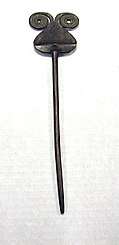
Social significance
Intricately woven mantles were created to be worn by nobles and elites, both in life and death. Mantles were often extensive and large, averaging 275 centimeters in length and 130 centimeters in width, and were draped around the neck and over the shoulders.[3] Women fastened fabrics at the front of the body with a tupu, or shawl pin. The size of the mantle and foreshortening effects of imagery contributed to the appearance of the wearer as being "larger than life," serving as explicit status symbols.[5]
Bright dyes served to distinguish social elite from those of lesser status, as undyed fabric worn by commoners was brown. Chinchero officers wore red ponchos to signify rank during formal government occasions.[3] Inca rulers wore a llautu, or tasseled red fringe, on their forehead to demonstrate their status.[13]
Gifts were also given to conquered territories in ceremonial shows of dominance over the peoples of the region. A region's ability to produce textiles was intricately connected to its success of camelid herding, indicating the value of state-controlled wealth in a territory.[14]
Burial bundles
Woven garments worn during life indicated an individual's social rank, and were often interred with the individual in death. Gift textiles created expressly for funerary purposes were also interred, without being worn in life. Ritual gift objects wrapped in "mummy bundles" include obsidian knives, combs, and balls of thread.[3]
Paracas culture practiced mummification by wrapping the deceased in several layers of woven textiles. Over 429 funeral bundles containing gift textiles, reams of plain cloth, and various ritual paraphernalia have been excavated from a necropolis at Cerro Colorado. These artifacts offer the largest source of pre-Columbian Andean textile arts known to date.[3]
Military use
While Andean civilizations had knowledge of and were capable of working metal, quilted armor was preferred for its light weight and flexibility. Soldiers depicted by Felipe Guaman Poma de Ayala wear cloth tunics and wind strips of fabric around themselves to create a sturdy armor that allowed for movement while providing defense. The use of cloth rather than metallic armor was also motivated by cultural reasons. The properties of cloth were believed to transfer spiritual reinforcement and power to its wearer, supplying strength and force.[10]
For similar reasons, woven slings made of plant fibers were the preferred weapons of Moche civilization, rather than stiff wooden or metallic implements.[10] Cloth blankets and tent-making equipment were readily transportable, allowing caches of resources to be delivered to battle frontiers. Storage warehouses containing cloth equipment have been excavated throughout Tawantin Suyu. Defeated armies forced to retreat often burned all cloth unable to be carried, preventing enemy forces from capturing these valuable stashes.[2]
Colonial Period

The Spanish conquest of the Inca Empire resulted in the immigration of Spanish settlers to on the Andean coast. Middle- and upper-class Spanish families recognized the value of finely woven native textiles, and demanded luxury textiles to decorate their own homes. As a result, cumbi, a fine tapestry cloth woven from alpaca fibers, was modified to a Spanish color palette and produced for the homes and churches of settlers.[15] The term tornasol refers to the style of textile absorbed by Andean weavers after the European context, characterized by a silky texture that appears to change color from different perspectives.[16]
Native weavers modified their technique to produce common items for their colonial audience. Bedcovers, table covers, rugs, and wall hangings became popular textile formats in the late 18th century. European influences introduced lace-inspired borders and stylized circular patterns.[15]
While garments had traditionally been brightly colored and highly patterned, the garments worn by highland Andeans during the Colonial period were characteristically plain and black. This has been interpreted as an act of mourning for the lost Inca empire, but may also be a result of cultural influence imported by arriving Spanish colonists.[16]
Gallery
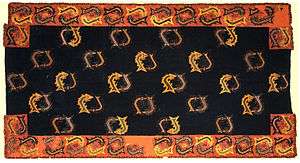
Nazca-Paracas mantle, 1-100 CE, Brooklyn Museum, Brooklyn. %2C_overall.jpg)
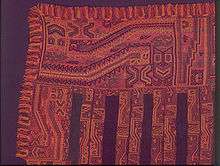
Paracas mantle, c. 200 C.E., Larco Museum, Lima. 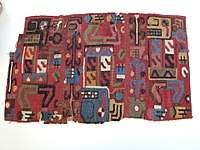
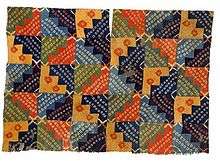
Wari tunic, 750-950 C.E., Textile Museum, Washington, D.C. 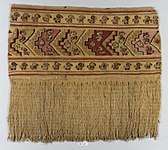
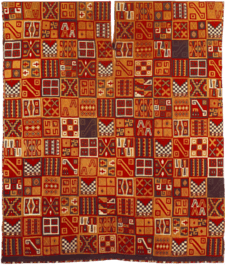
Tupa Inca tunic, c. 1550 C.E., Dumbarton Oaks, Washington, D.C. 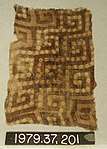
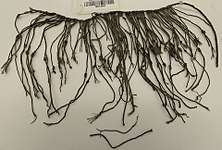
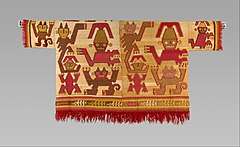
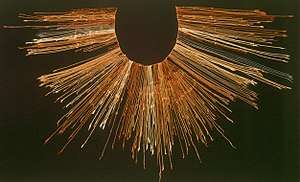
Incan quipu, date unknown, Larco Museum, Lima. .jpg)
See also
References
- ↑ "Blue jeans have a 6,000 year-old Peruvian ancestor". PBS NewsHour. Retrieved 2018-04-06.
- 1 2 Murra, John V. (August 1962). "Cloth and Its Functions in the Inca State". American Anthropologist. 64: 710–728. JSTOR 667788.
- 1 2 3 4 5 6 7 8 Anne., Paul, (1990). Paracas ritual attire : symbols of authority in ancient Peru. Norman: University of Oklahoma Press. ISBN 0806122307. OCLC 20724087.
- 1 2 3 1958-, Stone, Rebecca, (2002). Art of the Andes : from Chavín to Inca (2nd ed.). London: Thames & Hudson. ISBN 9780500203637. OCLC 49833926.
- 1 2 1958-, Stone, Rebecca, (1996). Art of the Andes : from Chavín to Inca. Jay I. Kislak Reference Collection (Library of Congress). New York: Thames & Hudson. ISBN 0500202869. OCLC 36461413.
- 1 2 The Ancient Americas : art from sacred landscapes. Townsend, Richard F.,, Aveni, Anthony F.,, Art Institute of Chicago,, Museum of Fine Arts, Houston,, Los Angeles County Museum of Art,. Chicago: Art Institute of Chicago. 1992. ISBN 3791311883. OCLC 26095624.
- ↑ "Nasca Cross-Knit Looping - Interweave". Interweave. 2018-02-14. Retrieved 2018-04-16.
- 1 2 1958-, Stone, Rebecca, (1994). To weave for the sun : ancient Andean textiles in the Museum of Fine Arts, Boston. Paul, Anne., Niles, Susan A., Young-Sánchez, Margaret., Museum of Fine Arts, Boston. London: Thames and Hudson. ISBN 0500277931. OCLC 31780747.
- 1 2 "Weaving and the Social World: 3,000 Years of Ancient Andean Textiles". artgallery.yale.edu. Retrieved 2018-04-06.
- 1 2 3 Lechtman, Heather (1993). Technologies of Power: The Andean Case. Cornell University Press. pp. 244–280. ISBN 1461490170.
- ↑ Heckman, Andrea M. (2006). "Colorful Messages: The Revival of Natural Dyes in Traditional Cuzco Textiles". Textile Society of America Symposium Proceedings.
- ↑ Barnard, Hans (2016). "Painted textiles: knowledge and technowledge in the Andes". Nawpa Pacha. 36: 209–228.
- ↑ "Male Figurine | Inca | The Met". The Metropolitan Museum of Art, i.e. The Met Museum. Retrieved 2018-04-10.
- ↑ "About Andean Textiles – Centro de Textiles Tradicionales del Cusco". www.textilescusco.org. Retrieved 2018-04-06.
- 1 2 ""T" is for Cumbi Tapestries: Peruvian Textiles in the Spanish Colonial Home. Julia McHugh, Douglass Foundation Fellow in American Art, The Metropolitan Museum of Art, New York". DRESSING THE NEW WORLD. Retrieved 2018-04-10.
- 1 2 Phipps, Elena (2000). "'Tornesol': a Colonial synthesis of European and Andean textile traditions". Textile Society of America Symposium Proceedings.
Sources
- Paul, Anne (1990). Paracas ritual attire: symbols of authority in ancient Peru. Norman: University of Oklahoma Press. ISBN 0806122307.
- Paul, Anne (1985). "The Stitching of Paracas Embroidered Images: Procedural Variations and Differences in Meaning". Anthropology and Aesthetics. 9: 91–100.
- Phipps, Elena (2004). The colonial Andes: tapestries and silverwork. New York: The Metropolitan Museum of Art. pp. 1530–1830. ISBN 1588391310.
- Phipps, Elena (2014). The Peruvian Four-Selvaged Cloth: Ancient Threads/New Directions. Seattle: University of Washington Press. ISBN 0984755055.
- Pillsbury, Joanne (2002). "Inka Unku: Strategy and Design in Colonial Peru". Cleveland Studies in the History of Art. 7: 68–103.
- Stone-Miller, Rebecca (2002). Art of the Andes: from Chavín to Inca. London: Thames and Hudson. ISBN 978-0-500-20363-7.
- Stone-Miller, Rebecca (1994). To Weave for the Sun: Ancient Andean Textiles in the Museum of Fine Arts, Boston. Boston: Thames and Hudson. ISBN 0500277931.
